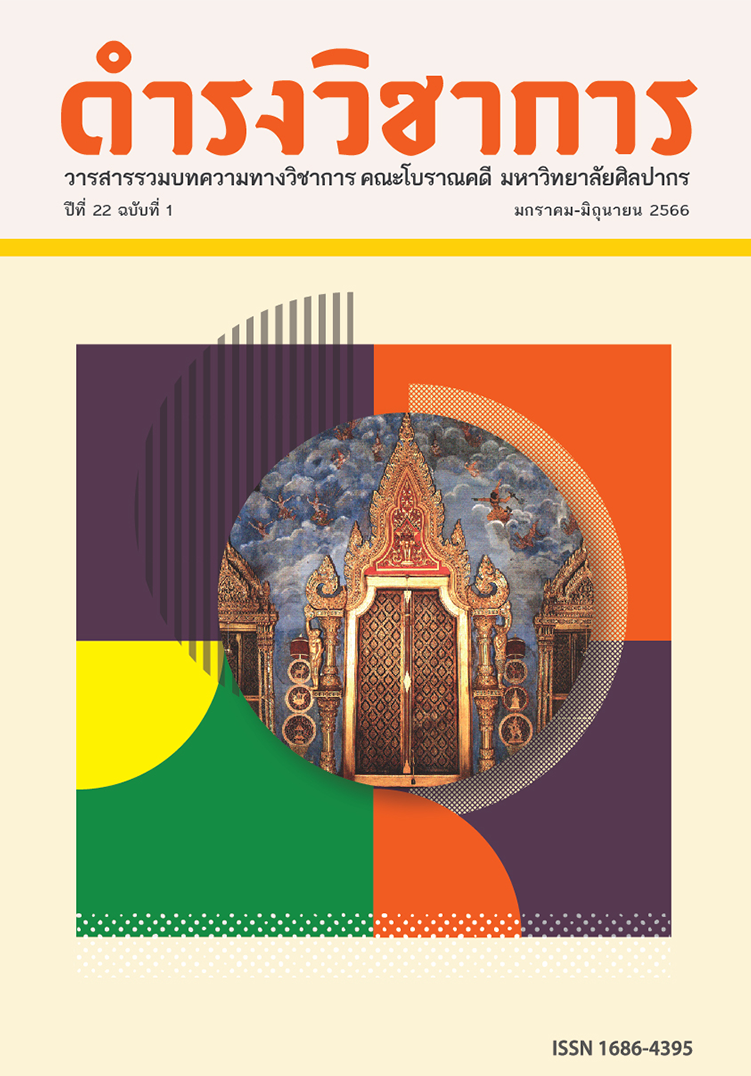Glass Beads from Archaeological Sites: Trade Relations between Southern and Foreign Countries Prior to the 14th Century A.D.
Keywords:
Glass Beads, Archaeological Sites in Southern Thailand, Ancient Trade RelationsAbstract
Ancient glass beads are considered to be important archaeological artifacts. Glass beads have been found in quantity from surveys and excavations at several archaeological sites in Thailand. This article aims to study the physical characteristics and chemical properties of glass beads found in some archaeological sites of southern Thailand and dated to the 14th century A.D. or earlier. Samples of them were sent for analysis using the Wavelength Dispersive X-ray Fluorescence Spectrometer (WD-XRF). Hypothetically, glass beads are regarded as indicators of trade relations between people of southern Thailand and other regions. The results reveal that physical characteristics and chemical components of glass beads found in the sites of southern Thailand closely resemble those of India, China, and the Middle East. Furthermore, the same type of glass beads have been found at various archaeological sites in Southeast Asia. This indicates trade and cultural contact between people of southern Thailand and those of Southeast Asian and overseas communities of the East and the West during the first centuries BCE to the 13th century A.D.
References
ภาษาไทย
ผุสดี รอดเจริญ, 2556. “การวิเคราะห์ลูกปัดแก้วจากเมืองโบราณสมัยทวารวดี ในภาคกลางของประเทศไทย.” วิทยานิพนธ์ปริญญาปรัชญาดุษฎีบัณฑิต สาขาโบราณคดีสมัยประวัติศาสตร์ ภาควิชาโบราณคดี บัณฑิตวิทยาลัย มหาวิทยาลัยศิลปากร.
อมรา ศรีสุชาติ, 2533. “หลักฐานโบราณคดีเกี่ยวกับสินค้าสำคัญในการค้าทางทะเล.” ศิลปากร 33 (6):
ภาษาอังกฤษ
Brill R. H., 1987. “Chemical analyses of some early Indian glasses.” In Archaeometry of
glass: Proceedings of the archaeometry session of the XIV international
congress on glass, 1986. New Delhi: Indian Ceramic Society.
Carolyn M. & Swan, 2017. “Compositional observations for Islamic glass from Siraf,
Iran, in the Corning Museum of Glass collection.” Journal of Archaeological
Science 16: 102–116.
Chau Ju-Kua, 1911. Chau Ju-Kua: His work on the Chinese and Arab trade in the
twelfth and thirteenth centuries, entitled Chu-fan-chi. Michigan: Printing Office of the Imperial Academy of Sciences.
Dussubieux L. & Gratuze B., 2010. “Mineral soda alumina glass: occurrence and meaning.” Journal of Archaeological Science 37: 1646.
______________, 2013 “Glass in South Asia.” In Modern methods for analyzing archaeological and historical glass. Belgium: Department of Chemistry, University of Antwerp.
Francis Jr P., 2020. Asia’s maritime bead trade 300 B.C. to the present. Honolulu:
University of Hawai’i Press.
Gan Fuxi, 2009. “The Silk Road and ancient Chinese glass.” In Ancient Glass Research
Along the Silk Road. Singapore: World Scientific.
Hall K. R., 1985. Maritime trade and state development in Southeast Asia. Hawaii: University of Hawaii Press.
Jiayao An, 1996. “Ancient glass trade in Southeast Asia.” In ancient trades and cultural
contacts in Southeast Asia. Bangkok: The Office.
Lankton J. W., 2006. “Glass from Khao Sam Kaeo: Transferred technology for an early Southeast Asian exchange network.” Bulletin de l’École française d’Extrême-Orient 93: 317-351.
Lankton J. W. & Dussuieux L., 2006. “Early glass in maritime trade: A review and an interpretation of compositional analyses.” Journal of Glass Studies 48: 120-144.
Wang & K-W, 2021. “Glass beads from Guishan in iron age Taiwan: inter-regional
bead exchange between Taiwan, Southeast Asia and beyond.” Journal of
Archaeological Science: Reports 35: 1-15.
Downloads
Published
Issue
Section
License
Copyright (c) 2023 Damrong Journal of The Faculty of Archaeology Silpakorn University

This work is licensed under a Creative Commons Attribution-NonCommercial-NoDerivatives 4.0 International License.
บทความนี้เป็นผลงานของข้าพเจ้าแต่เพียงผู้เดียว และ/หรือเป็นผลงานของข้าพเจ้าและผู้ร่วมงาน ตามชื่อที่ระบุในบทความจริง และเป็นผลงานที่มิได้ถูกนำเสนอหรือตีพิมพ์ที่ใดมาก่อน





